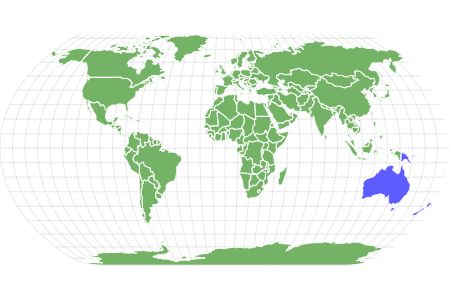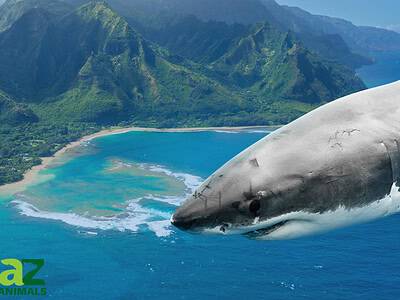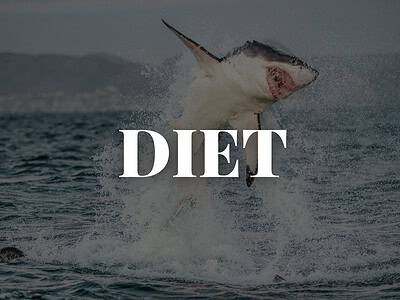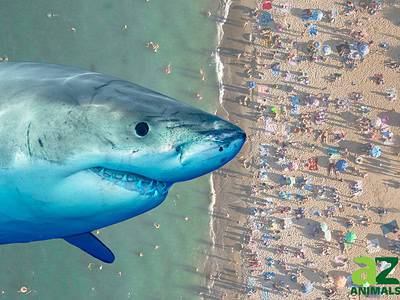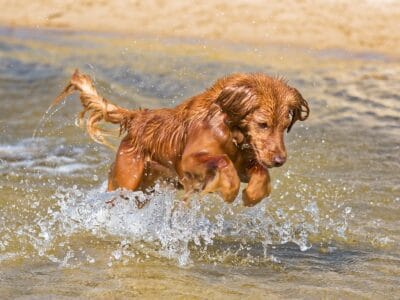Inhabits tropical coastal waters of Australia!
Advertisement
Sea Dragon Scientific Classification
- Kingdom
- Animalia
- Phylum
- Chordata
- Class
- Actinopterygii
- Order
- Syngnathiformes
- Family
- Syngnathidae
- Genus
- Phycodurus
- Scientific Name
- Phycodurus eques
Read our Complete Guide to Classification of Animals.
Sea Dragon Conservation Status
Sea Dragon Facts
- Main Prey
- Plankton, Shrimp, Small fish
- Distinctive Feature
- Elongated snout and easily camouflaged body
- Optimum pH Level
- 6.5 - 8.0
- Habitat
- Tropical coastal waters
- Predators
- Large Fish
- Diet
- Carnivore
- Favorite Food
- Plankton
- Common Name
- Sea Dragon
- Average Clutch Size
- 250
- Slogan
- Inhabits tropical coastal waters of Australia!
View all of the Sea Dragon images!
Poor swimmers, but great at camouflage, sea dragons are a unique type of pipefish!
While their names may not suggest it, sea dragons are fish that are actually poor swimmers who typically drift with the currents instead of putting forth the effort to swim. This often bright-colored fish lives in the ocean around Australia and Tasmania. They rely on their camouflage to protect them from predators and survive by eating tiny prey, such as small fish and crustaceans – even though they have no teeth.
5 Sea Dragon Facts
• The male sea dragon has a patch near his tail where he carries the eggs the female lays.
• Only three types of sea dragons are known, with the newest one, the ruby sea dragon, having been discovered in 2015.
• Sea dragons are camouflaged to blend in with their environment.
• All types of sea dragons are carnivorous.
• A male leafy sea dragon’s tail turns bright yellow when he is ready to breed.
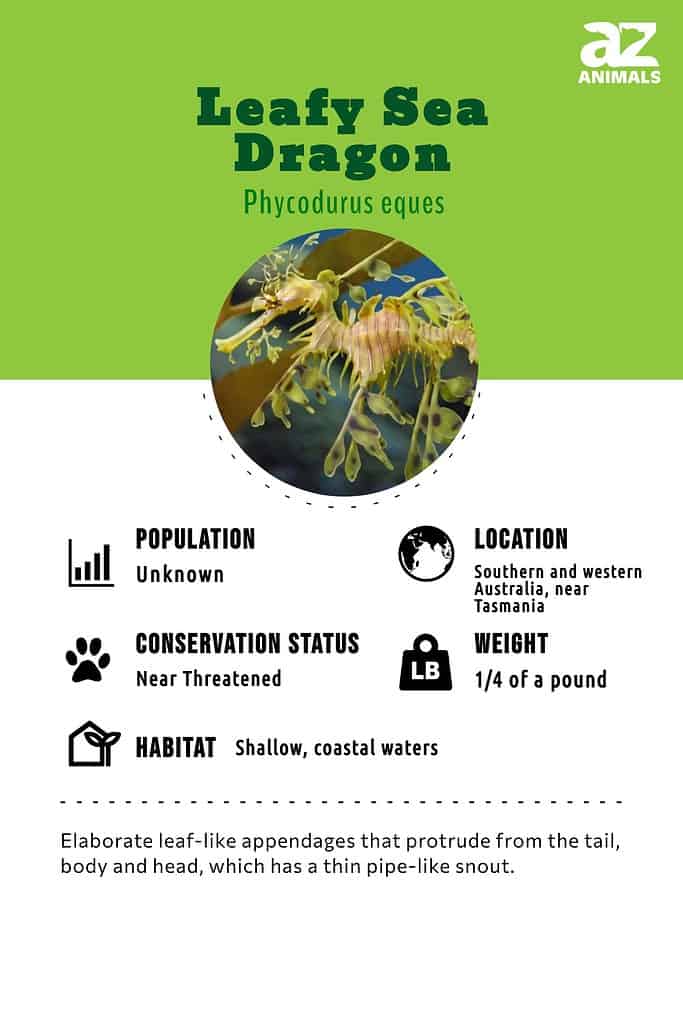
Scientific Name
Three different types of sea dragons have been identified. The first of these is the leafy sea dragon, Phycodurus eques. Phycodurus comes from the Latin words “phyko,” meaning seaweed, and “oura,” meaning tail. The term eques is from the Latin “equus,” meaning horse.
The second type of sea dragon is the weedy sea dragon, Phyllopteryx taeniolatus, also sometimes called the common sea dragon. The first part of its scientific name comes from the Greek words for leaf, “phyhllon,” and the word for a fin or wing, “pteryx.” The second part of its name is based on the Latin word “taeniolar,” meaning ribbons.
Finally, the third known species of sea dragon is the ruby sea dragon, Phyllopteryx dewysea. The first part of its name is the same as that of the weedy, or common, sea dragon. The second part of its scientific name, dewysea, honors a longtime sea dragon supporter and researcher, Mary “Dewy” Lowe, with the word “sea” included because of her deep love of the sea.
Evolution And History
The oldest recorded fossil found of a sea dragon was from most likely more than 180 million years ago and 33 feet long, leading researchers to believe that the ancestors were much larger than the species we see today. The leafy seadragon is part of the larger family Syngnathidae, which also includes seahorses and pipefish, although their specific species of only 3 sea dragons are incredibly rare.
It is believed that they evolved their features fairly quickly, due to repetitive DNA sequences that are called jumping genes.
Appearance And Behavior
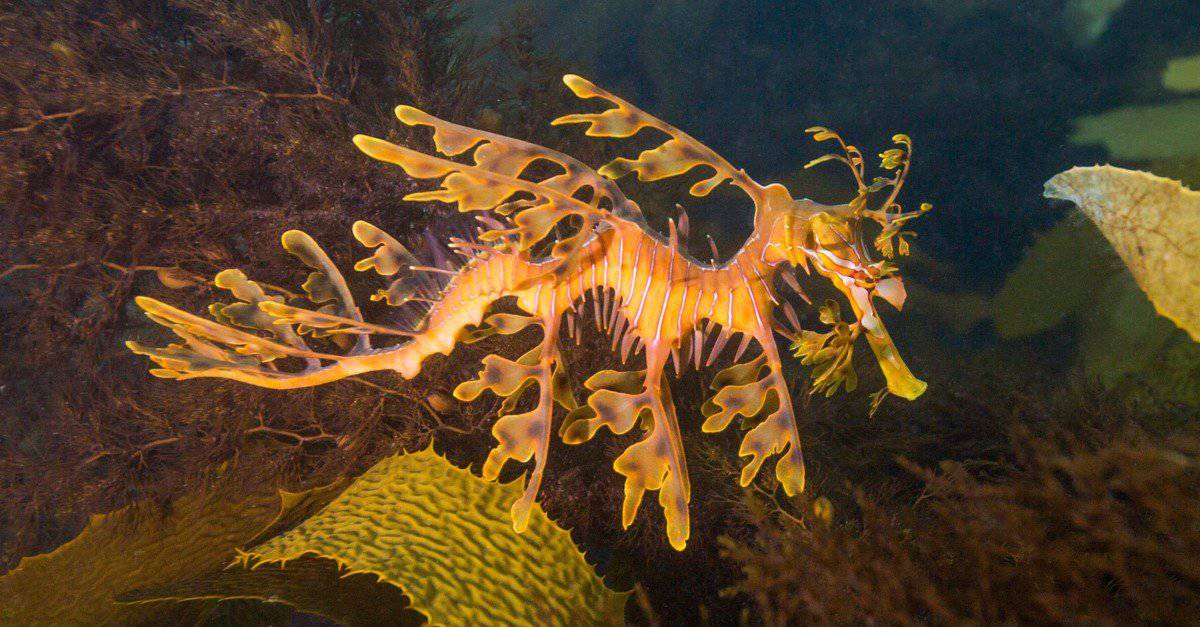
Leafy Sea dragons do not have any predators. Their combination of excellent camouflage, tough jointed plates and sharp dorsal spines offer adequate protection.
©AshtonEa/Shutterstock.com
These animals are a type of pipefish, with long, narrow bodies and tails. They also have camouflage to help to protect them from predators. For example, the leafy sea dragon’s body is covered with leaf-like appendages that help it to hide in seaweed and kelp. Its coloring is yellow to brown, with olive-colored spots that add to its ability to hide in the underwater plants where it makes its home.
Conversely, the weedy sea dragon has just a few appendages, but these are just enough to break up its outline and help it to blend in with its environment. This fish typically lives on the ocean floor rather than in seaweed and kelp – with reddish coloring and yellow spots or markings.
The ruby sea dragon is a deep red color with just a few very short, stump appendages. Not much is known about this sea dragon, but scientists think that its color helps to hide it in the deeper water where it lives because red is almost invisible in the depths of the ocean.
All three types of these animals tend to drift with the currents because they are not strong swimmers. They hide and wait for their prey, ambushing it when it gets close to them rather than chasing down their food. They do have small fins along their backs and sides that they can use for propulsion, but these nearly invisible fins aren’t very powerful and are mostly used for maneuvering and slow swimming. Neither the leafy nor the weedy sea dragons have prehensile tails, meaning they can’t hold onto branches or anything else with their tails, but ruby sea dragons do have prehensile tails and use them to keep themselves in one spot when they choose to do so.
Sea dragons are shy, solitary fish that do not live in large schools, though they have been observed living in pairs. Most of the time, they float freely in the water without making any effort to control where they are going, looking more like bits of seaweed than fish. Individuals vary greatly in length, but in general sea dragons can reach up to 18 inches in length, a bit longer than the height of a bowling pin. Leafy sea dragons are smaller than weedy sea dragons.
Habitat
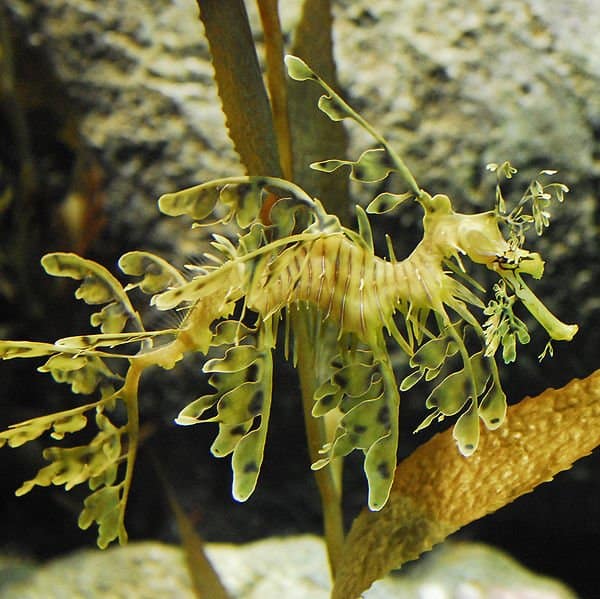
Sea Dragons live in shallow, coastal waters but may be found at depths of up to 150 feet.
©EyeKarma (original photograph); Papa Lima Whiskey (derivative edit) / public domain – Original / License
These animals are only found in the ocean near Southern and Western Australia and around Tasmania. For the most part, they live in shallow, coastal waters, but may be found at depths of up to 150 feet. Ruby sea dragons have been found living in much deeper water than the other species, which may be why they were not discovered until recently. All sea dragons live in or near seaweed, kelp forests, along rocky reefs, or in and around seagrass beds, though they also often drift freely in and around the ocean plant life.
However, the similar-looking seahorse is much more widespread and includes 46 recognized species.
Diet
These animals are carnivores but are limited to what they can eat because their mouths form long tubes and they do not have jaws that open. Sea dragons wait in hiding for their prey, ambushing and eating any creatures small enough to fit in their mouths. They eat fish larvae, tiny crustaceans, very small fish, sea lice, mysid shrimp, worms, and zooplankton.
They swallow their food whole because they lack working jaws for chewing, plus they have no teeth. To capture their prey, they use powerful suction from their jaws that sucks in the victim. They must consume everything they eat as though they were drinking it through a straw. Once it’s in their mouths the sea dragons can swallow their prey whole.
Predators And Threats
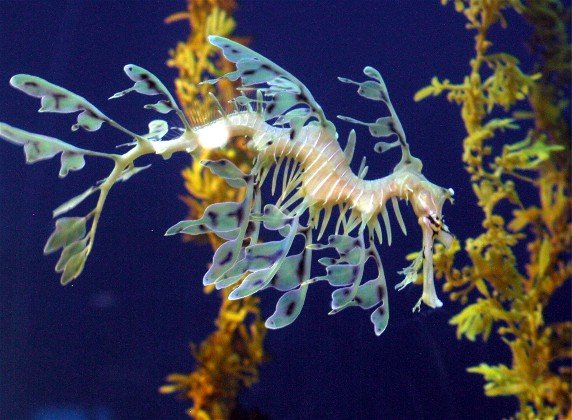
Sea Dragons aren’t appealing to predators because they are very bony.
©Wendy Rathey / Creative Commons – Original
It is unknown which, if any, predators these animals have to fear. Scientists think that the sea dragons’ camouflage helps them to avoid drawing attention to themselves, so they are not as much of a target as many other species. They are also quite bony, possibly making them less appealing to predators than many other fish. However, if a predatory fish such as a shark happens upon them, it is still likely to make a meal of it since sea dragons have no defense except for their ability to hide. Almost anything will consume babies, as they lack the camouflage of the adults, plus they hatch all at once, so they’re easy for predators to find. Not many of the young survive to grow up.
The main threat to the continued existence of these animals is the destruction of habitat, mainly the loss of seaweed and seagrass beds. This is caused by human activity, especially pollution, as well as changes brought about by global warming. These animals have also been harvested by humans to be kept as aquarium pets, an activity that severely diminished the population. In the 1990s, laws were enacted in most places where sea dragons are found that protected them, and at this point, the population appears fairly stable. Sea dragons do sometimes end up entangled in fishing nets and usually die as a result, but this doesn’t generally kill large numbers of them.
The current conservation status of these animals is near threatened (NT), according to the International Union for the Conservation of Nature (IUCN). The population numbers for these animals seem adequate to support them in the wild at this time, but it is possible that could change if the loss of habitat continues.
Reproduction, Babies, And Lifespan
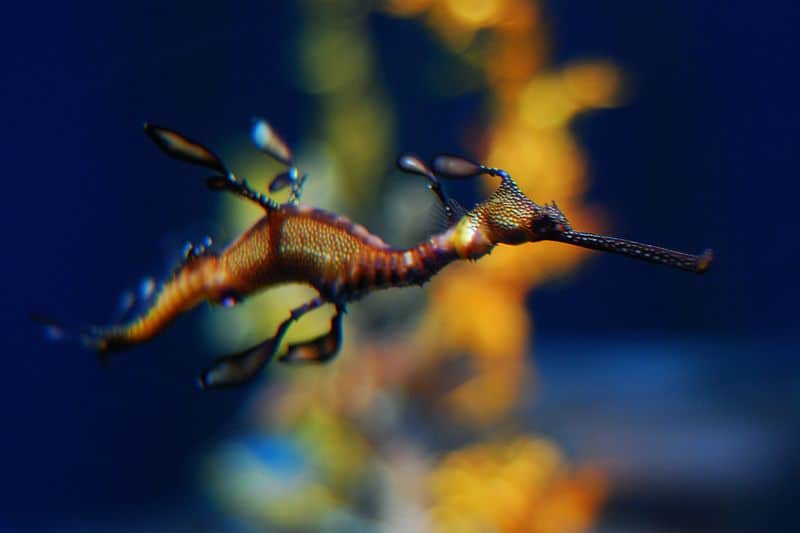
Once a couple has formed, they will stay together until their eggs are laid.
©Fernando Estel / Creative Commons – Original
Very little is known about the mating rituals of these animals. They do appear to have a courtship of some sort where the male approaches the female when it is time to breed. It is unknown just what triggers mating behavior in them though. However, it is believed males may fight other males for the right to breed.
When the time is right the female deposits her pink eggs on a spongy patch of skin under the male’s tail. He fertilizes them as they are deposited. She will lay anywhere from 100 to 300 eggs at a time. The male’s skin forms tiny cups to hold the eggs in place, keeping them safe and oxygenated until they hatch. This can take anywhere from four to eight weeks, depending on the conditions, especially water temperature. The warmer the water, the sooner the eggs will hatch. Once a couple has formed, they will stay together until the eggs are laid.
When the babies (also called fry) hatch, they look like tiny versions of their parents, except that they lack any of the camouflaging appendages the adults have. These start growing soon after birth, but they won’t do the new hatchlings any good for at least a few days. Since the male’s job is done as soon as the babies hatch, and the female has left long before, the young get no care or adult protection from the moment they emerge into the world. The lack of both camouflage and parental care makes the new babies easy targets for predators and results in a high rate of mortality.
The lifespan of these animals is anywhere from three to ten years, with six being the average age for them. They can breed when they are around a year old, but it is more common to wait to breed until they are sexually mature at about two years of age.
Population
There has never been an accurate count of the population of these animals and it is unknown how many of them exist in the wild. The leafy sea dragon’s numbers are currently endangered due to a loss of habitat as a result of pollution, human destruction, and dangerous fishing practices. There is a special concern for these fish because they inhabit such a limited range, so if their habitat is damaged or destroyed they are likely to die rather than relocate.
View all 292 animals that start with SSea Dragon FAQs (Frequently Asked Questions)
What do sea dragons eat - are they carnivores, herbivores, or omnivores?
Sea dragons are carnivores. They eat only meat, which includes fish, shrimp, sea lice, zooplankton, worms, and other tiny creatures that it can suck into its long, straw-like mouth.
What eats a sea dragon?
Sea dragons have such excellent camouflage that they are safe from most predators, but if they are spotted by predatory fish they may be eaten. Newly hatched babies are commonly eaten by any fish that happen to be near when they hatch, as this is when they’re easy to see.
How much does a sea dragon cost?
It is not possible to buy a sea dragon. They are protected by law in Australia and Tasmania and are not available to hobbyists who want to buy them.
Are sea dragons dangerous?
Sea dragons are not dangerous. They are shy creatures and cannot move fast. They also lack any way to cause harm to anything too big to fit into their straw-like snouts. Sea dragons do not have any teeth, claws, or venom.
How big is a sea dragon?
When sea dragons first hatch, they are tiny, looking like miniature versions of their parents, lacking only the protective camouflage that they will begin to grow within a few days after birth. The largest sea dragons measure 18 inches long.
What are the different types of sea dragons?
There are three types of sea dragons: the weedy sea dragon (also known as the common sea dragon), the leafy sea dragon, and the ruby sea dragon.
Are seahorses related to sea dragons?
Seahorses and sea dragons are related. They both belong to the order Syngnathiformes and the family Syngnathidae. They share many characteristics that can be seen when visually comparing the two. However, seahorses belong to the genus Hippocampus, while sea dragons belong to either the genus Phycodurus or Phyllopteryx. They do have similarities and some things in common, but they are also very different creatures.
What is a sea dragon rocket?
A sea dragon rocket is not an animal, but a rocket program developed in 1962 for launching heavy loads into space. The concept called for the sea dragon rocket to launch from the ocean, but the project was never built and was ultimately abandoned.
What is a sea dragon leviathan?
A sea dragon leviathan is not an actual creature, but is instead a ferocious beast that only lives in fantasy books and video games. The name was drawn from the real animal, but they have nothing else in common.
What Kingdom do Sea Dragons belong to?
Sea Dragons belong to the Kingdom Animalia.
What phylum do Sea Dragons belong to?
Sea Dragons belong to the phylum Chordata.
What class do Sea Dragons belong to?
Sea Dragons belong to the class Actinopterygii.
What family do Sea Dragons belong to?
Sea Dragons belong to the family Syngnathidae.
What order do Sea Dragons belong to?
Sea Dragons belong to the order Syngnathiformes.
What genus do Sea Dragons belong to?
Sea Dragons belong to the genus Phycodurus.
What type of covering do Sea Dragons have?
Sea Dragons are covered in Scales.
In what type of habitat do Sea Dragons live?
Sea Dragons live in tropical coastal waters.
What are some distinguishing features of Sea Dragons?
Sea Dragons have elongated snouts and easily camouflaged bodies.
What is the average clutch size of a Sea Dragon?
Sea Dragons typically lay 250 eggs.
What is an interesting fact about Sea Dragons?
Sea Dragons inhabit the tropical coastal waters of Australia!
What is the scientific name for the Sea Dragon?
The scientific name for the Sea Dragon is Phycodurus Eques.
What is the lifespan of a Sea Dragon?
Sea Dragons can live for 2 to 10 years.
What is the optimal pH for a Sea Dragon?
The optimal pH for a Sea Dragon is between 6.5 and 8.0.
How do Sea Dragons have babies?
Sea Dragons lay eggs.
What are the differences between sea dragons and seahorses?
Sea dragons and seahorses are similar sea creatures that differ in several ways. Sea dragons and seahorses are closely related, but sea dragons only have two species, live in Australia, and look like drifting seaweed. Seahorses are found all over the world, have nearly 50 species, and have a bony appearance.
Thank you for reading! Have some feedback for us? Contact the AZ Animals editorial team.
Sources
- David Burnie, Dorling Kindersley (2011) Animal, The Definitive Visual Guide To The World's Wildlife / Accessed December 21, 2009
- Tom Jackson, Lorenz Books (2007) The World Encyclopedia Of Animals / Accessed December 21, 2009
- David Burnie, Kingfisher (2011) The Kingfisher Animal Encyclopedia / Accessed December 21, 2009
- Richard Mackay, University of California Press (2009) The Atlas Of Endangered Species / Accessed December 21, 2009
- David Burnie, Dorling Kindersley (2008) Illustrated Encyclopedia Of Animals / Accessed December 21, 2009
- Dorling Kindersley (2006) Dorling Kindersley Encyclopedia Of Animals / Accessed December 21, 2009
- Science Alert / Published June 29, 2022 / Accessed March 17, 2023

